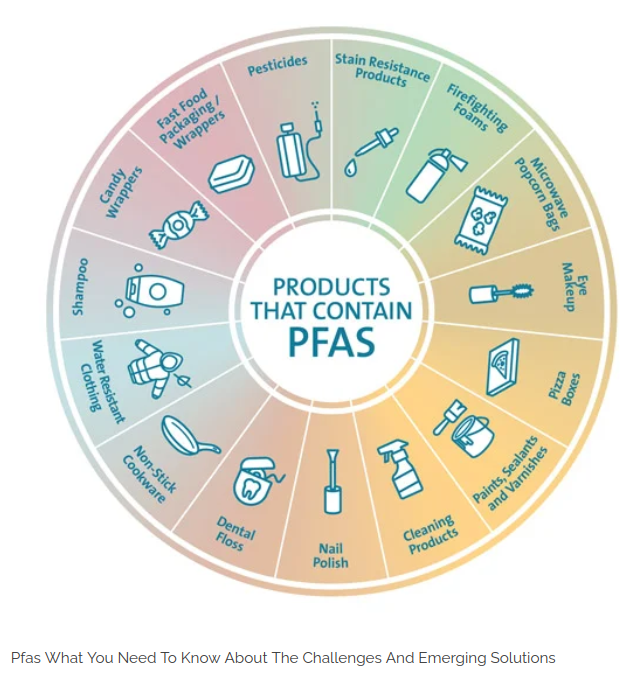In recent years, you may have heard the term PFAS (per- and polyfluoroalkyl substances) cropping up in the news, especially regarding water contamination, food packaging, and industrial products. But what exactly are PFAS, and why should we be concerned about their presence in our environment and our bodies?
What Are PFAS?
PFAS are a group of over 4,000 human-made chemicals that have been widely used in industrial and consumer products for more than 60 years. They are commonly found in products that repel water, grease, and stains, such as non-stick cookware, waterproof clothing, food packaging, and firefighting foam. The unique properties of PFAS, such as their ability to resist heat, water, and oil, have made them a popular choice in various industries.

However, this durability is a double-edged sword. Unlike many other chemicals, PFAS do not break down easily in the environment or the human body, earning them the nickname “forever chemicals.”
Why Are PFAS a Health Concern?
One of the biggest concerns with PFAS is that they are persistent — both in the environment and in our bodies. Studies have shown that PFAS can accumulate over time in the blood, organs, and tissues, potentially leading to harmful health effects. Here are some of the health risks associated with PFAS exposure:
1. Cancer Risk
Exposure to certain types of PFAS has been linked to an increased risk of various types of cancer, particularly kidney and testicular cancer. These chemicals are believed to disrupt the normal functioning of cells and tissues, leading to the formation of tumors.
2. Endocrine Disruption
PFAS have been shown to interfere with the body’s endocrine system — the network of glands that produce hormones. This disruption can lead to a variety of issues, including thyroid disease, developmental problems in infants, and hormonal imbalances.
3. Immune System Impact
Research has found that PFAS exposure can weaken the immune system, making the body less effective at fighting infections and diseases. Individuals with higher levels of PFAS in their blood may have a reduced response to vaccinations and may be more susceptible to illnesses.
4. Liver Damage
Certain types of PFAS have been shown to damage the liver, leading to issues like fatty liver disease and reduced liver function. This can result in long-term health complications and may increase the risk of liver cancer.
5. Reproductive Health
PFAS exposure is also a concern for reproductive health. Studies suggest that these chemicals may interfere with fertility, causing issues such as reduced sperm quality in men and pregnancy complications in women, including low birth weight and developmental delays in children.
How Are We Exposed to PFAS?
PFAS can enter our bodies in various ways, often without us even realizing it. The most common routes of exposure include:
- Drinking Contaminated Water: PFAS have been found in drinking water supplies in many regions, particularly near industrial areas or military sites that have used firefighting foam. Water contamination is one of the most significant sources of exposure to PFAS.
- Consuming Contaminated Food: PFAS can accumulate in the food chain, particularly in fish, meat, and dairy products. Food packaging materials, such as fast food wrappers and microwave popcorn bags, can also contain PFAS.
- Using Household Products: Many everyday products, such as non-stick cookware (Teflon), stain-resistant carpets, waterproof clothing, and some cosmetics, may contain PFAS.
- Living in Industrial Areas: People who live near factories or military bases where PFAS are used or manufactured are at higher risk of exposure, particularly through air and water contamination.
What Can You Do to Protect Yourself?
While PFAS are nearly impossible to avoid completely, there are steps you can take to minimize your exposure:
- Test Your Water: If you live in an area where PFAS contamination is a concern, consider testing your drinking water for these chemicals. Many communities offer free testing or low-cost testing services.
- Be Cautious About Non-Stick Cookware: If you use Teflon or other non-stick cookware, consider switching to alternatives like stainless steel, cast iron, or ceramic pans that do not contain PFAS.
- Avoid Fast Food and Takeout Packaging: PFAS are often used in the packaging of fast food and takeout containers. Opt for homemade meals or choose restaurants that use PFAS-free packaging.
- Check Your Cosmetics: Some cosmetics, particularly foundations, mascaras, and nail polishes, may contain PFAS. Look for brands that advertise themselves as PFAS-free or check the ingredient labels for any suspicious chemicals.
- Support Legislation and Cleanup Efforts: Advocate for stronger regulations around PFAS use and support efforts to clean up contaminated water supplies. Many environmental organizations are working hard to raise awareness and push for policies that reduce the use of these harmful chemicals.
Raising Awareness
The growing awareness of the health risks associated with PFAS is driving increased research, public advocacy, and policy changes. In response to concerns, various countries and states have begun to regulate the use of PFAS, and some companies have started phasing out their use in products.
However, there is still a long way to go. As more data emerges about the dangers of these “forever chemicals,” it is crucial that we continue to educate ourselves and our communities about the potential risks of PFAS and take steps to limit exposure.
In the end, the key to protecting ourselves and future generations from the dangers of PFAS lies in understanding the risks, making informed choices, and pushing for meaningful change in policy and industry practices.